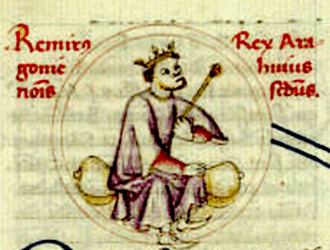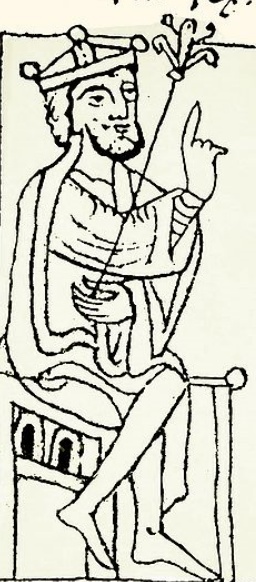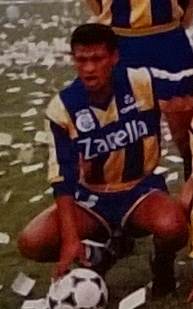Discover Your Roots
SIGN UPDiscover Your Roots
SIGN UPRamiro is a male name of Spanish origin, derived from the Latinization of the Gothic given name *𐍂𐌰𐌽𐌰𐌼𐌹𐍂 (*Ranamir). The name Ramiro means "Supreme Judge" and "Famous Advice." It has been historically associated with nobility and leadership, as reflected in notable figures such as kings, politicians, athletes, and artists. With a rich heritage, the name Ramiro exudes strength, wisdom, and influence. Whether it's the legacy of historical rulers or the achievements of modern-day professionals, the name Ramiro carries a sense of authority and distinction. Its Spanish roots and powerful meaning make it a captivating choice for parents seeking a name with historical significance and a strong, enduring presence.

Ramiro II, also known as Ramiro the Monk (24 April 1086 – 16 August 1157), was a prominent member of the House of Jiménez and the king of Aragon from 1134. Despite his monastic background, he was chosen by the Aragonese nobility to succeed his brother, Alfonso the Battler. His reign was marked by significant events, including the unification of Aragon and Barcelona through the marriage of his daughter, Petronilla, to Count Ramon Berenguer IV. This union led to the formation of the influential Crown of Aragon. Ramiro's rule faced challenges and internal conflicts with the nobles, but his decision to marry his daughter strategically strengthened the kingdom's position. After relinquishing his royal duties to his son-in-law, Ramiro retreated to a monastery, where he passed away in 1157. Despite stepping down from the throne, his legacy and influence persisted, as evidenced by his daughter's use of the title "queen" and the enduring mention of his name in chronicles from other kingdoms. Ramiro II's impactful contributions to the history of Aragon and the Crown of Aragon continue to be studied and celebrated.

Ramiro I (before 1007 – 8 May 1063) was the first King of Aragon from 1035 until his passing. Despite ruling a modest and unfederated kingdom, often referred to as a petty kingdom, his legacy was marked by the expansion of the nascent Kingdom of Aragon through the acquisition of territories such as Sobrarbe, Ribagorza, and the city of Sangüesa. Ramiro's son, Sancho Ramírez, succeeded him and became the King of Aragon and Pamplona. Born as the illegitimate son of Sancho III of Pamplona and his mistress Sancha of Aybar, Ramiro was reputed to have been adopted by his father's wife, Muniadona. His exact status remains vague, as he was referred to as both king and baiulus (steward). Ramiro sought to expand his lands by gaining territory from the Moors and his brother, García, the King of Navarre. Following his death in the Battle of Graus in 1063, he was buried at the monastery of San Juan de la Peña in Santa Cruz de la Serós.Ramiro had a son, Sancho, with his mistress Amuña, and five children with his first wife, Gisberga, who changed her name to Ermesinda upon marrying him. His second wife was Agnes, and no children are known from this marriage.Ramiro

Ramiro Castillo Salinas, known as "Chocolatín," was a revered Bolivian footballer, born on March 27, 1966. He made significant contributions to both club and international football before his untimely death on October 18, 1997. Castillo's career saw him excel as a midfielder, amassing 52 caps and scoring 5 goals for Bolivia from 1989 to 1997. Notably, he participated in the 1994 FIFA World Cup and played in four Copa America tournaments. His club career was equally impressive, with stints at renowned clubs such as The Strongest, River Plate, and Rosario Central in Argentina. Tragically, the loss of his 7-year-old son to fulminating hepatitis led to his own untimely passing at the age of 31. His legacy lives on through his remarkable achievements on the field, and his memory was honored through various tributes in Bolivia and Argentina. Castillo's impact on the footballing world remains indelible, cementing his status as a beloved figure in the sport.

Ramiro Corrales, born on March 12, 1977, is a former professional soccer player renowned for his contributions to the San Jose Earthquakes in Major League Soccer (MLS). Known for his defensive prowess, composure, and dedication to enhancing his teammates' performance, Corrales made his mark as the last active MLS player from the league's inaugural season in 1996 until his retirement in 2013. His journey in professional soccer began when he joined the San Jose Clash, later renamed the Earthquakes. Throughout his career, he also played for MetroStars, HamKam, and Brann, showcasing his versatility and skill across various clubs. Notably, his time with San Jose Earthquakes saw him as a key player in winning the 2001 and 2003 MLS Cups. Corrales' impact extended beyond the field, as his performances garnered accolades such as being named the club player of the year at Hamarkameratene. With a career spanning over a decade, Ramiro Corrales left an indelible legacy in American soccer, leaving a lasting impression on fans and fellow players alike.

Ramiro Pez, born on December 6, 1978, in Córdoba, Argentina, is a distinguished Italian Argentine rugby union footballer renowned for his exceptional skills at fly-half. His illustrious career includes stints with various esteemed clubs, such as Toulon, Venezia Mestre, Rugby Roma, Rotherham, Leicester Tigers, Bath, and USA Perpignan. Pez made his international debut with the Italian national team in 2000 and played a pivotal role in their historic victory against Argentina in 2005. Known for his impressive point-scoring abilities, he has left an indelible mark on the rugby world. Despite setbacks, such as a challenging season at Toulon, Pez's resilience and talent have solidified his reputation as a formidable force in the sport. Additionally, his Italian heritage adds a personal touch to his remarkable journey. With a strong connection to his roots and a passion for the game, Ramiro Pez continues to inspire and make an impact both on and off the field.
All images displayed on this page are sourced from Wikipedia or Wikimedia Commons.We use these images under their respective Creative Commons or public domain licenses. Wherever applicable, author attributions and license information are provided. If you believe an image is used incorrectly or outside its license terms, please contact us so that we can review and correct the issue.